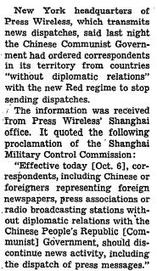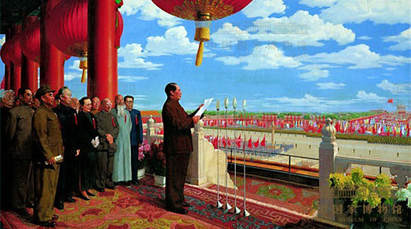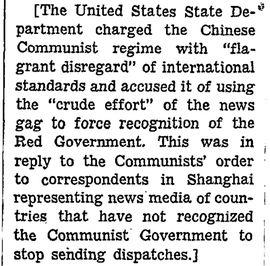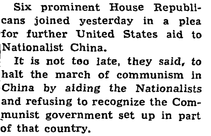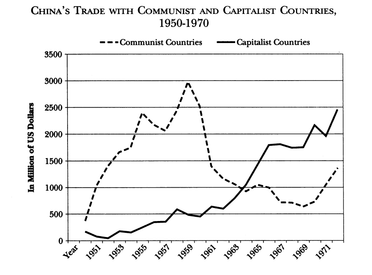Immediately after World War II, factors in China plunged the nation into a bloody civil war. Chiang Kai Shek and the Chinese Nationalist Party were supported by the United States while Mao Zedong and the Communist Party were backed by the Soviet Union. In 1949, the war came to an end: Chiang and his army retreated to the island of Taiwan and the Communist Party established the People's Republic of China on the mainland. For the next two decades, the PRC and the U.S. had virtually no contact with each other.
Two Opposite Foreign Policies
|
Chinese Perspective:
With the birth of the PRC, a new foreign policy was established. Zhou Enlai, the first Chinese Foreign Minister, summarized China's attitude as “sweep the house clean before inviting the guests,” which meant China would clean up past colonial influence before establishing diplomatic relations with Western “imperialist countries.” The new government treated Americans in China harshly. The American press was forbidden to report news [1], and the new government refused to accept diplomatic protocols [2]. Chairman Mao stated that China must only stand with communist countries [3]; building Sino-Soviet relations was the primary objective in foreign policy. |
[1]New York Times. "Red China Sets Relations as Price of News Activity." Oct 7, 1949. |
[2]"China Reds Suppress Facts, U.S. Says." The Washington Post, 3 Nov. 1949. |
|
American Perspective:
In the decades after the PRC was established, conflicts escalated. The U.S. refused to recognize the validity of the communist government [4]; it continued blocking China’s membership in the United Nations while supporting the regime in Taipei [5]. American policymakers considered China a threatening, ambitious power that wanted to expand communism in Asia. As such, the U.S. viewed China as an enemy and tried to block its development wherever possible. |
|
Interview Section:
Dr. George Esenwein University of Florida |
“The communist victory in the Chinese civil war that ended in 1949 caught most U.S. politicians by surprise...The U.S. had seen China as a firm ally during the Second World War. After the defeat of Japan in September, 1945, the U.S. (and the Soviet Union) fully expected China to remain under the leadership of the Nationalist (Kuomintang), Chiang Kai-shek...Because the victory of Mao meant extending communist influence in Asia, the U.S. government refused to recognize the legitimacy of the People’s Republic of China. Instead, the U.S. reaffirmed its support of Chiang’s Nationalist movement...” |
Military and Economic Conflicts:
During the civil wars in Korea and Vietnam, China and the U.S. supported opposite sides. Even though China wanted to establish trade with the U.S in 1950, in an effort to salvage its domestic economy from the ashes of war and natural disasters, the U.S. imposed a total trade embargo on China in retaliation for the Korean War [6]. Additionally, the U.S chose to station forces on Taiwan as a sign of support for the Nationalist Party[7]. In the end, military conflicts gave rise to international trade isolationism.
During the civil wars in Korea and Vietnam, China and the U.S. supported opposite sides. Even though China wanted to establish trade with the U.S in 1950, in an effort to salvage its domestic economy from the ashes of war and natural disasters, the U.S. imposed a total trade embargo on China in retaliation for the Korean War [6]. Additionally, the U.S chose to station forces on Taiwan as a sign of support for the Nationalist Party[7]. In the end, military conflicts gave rise to international trade isolationism.
|
[6]Chen, Xin-zhu J. “China and the US Trade Embargo, 1950-1972.” American Journal of Chinese Studies
|
[7]... |
|
Jiayong Lu | Senior Division
Website Individual 2018 NHD 2nd Place Winner |
website word count:1197 words process paper word count: 474 words video length: 3 min 55 sec |
